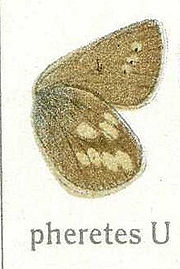
Albulina pheretes
Encyclopedia
The Mountain Blue is a small butterfly
found in the Himalayas
that belongs to the Lycaenids or Blues
family.
 Male upperside is purplish blue with dark blue at the bases of the wings. Fore and hind wings with somewhat obscure, slender, black, anticiliary lines, followed by very full, snow-white cilia.
Male upperside is purplish blue with dark blue at the bases of the wings. Fore and hind wings with somewhat obscure, slender, black, anticiliary lines, followed by very full, snow-white cilia.
The underside is grey, pale plumbeous brown on the discs of the wings, the bases of both fore and hind wings irrorated with bluish-green scales. Fore wing has a narrow transverse black lunule on the discocellulars and a transverse curved discal series of five white spots, each spot centred with black. Hind wing has a streak in the cell, a spot above it near the costa and a discal series of five spots, of which the posterior four are in a very oblique line directed outwards, and the upper or fifth is much larger, placed much further inwards above the apex of the cell. In the type and a few others the discal spots are seven or eight in number, and smaller than in the majority of specimens. Antennae dark brown, the shafts as usual ringed with white; head, thorax and abdomen clothed with bluish hairs; the palpi fringed with black hairs, thorax and abdomen white.
The female is similar to the male, but on the upperside the ground-colour is rich brown, the bases of the wings only blue. Underside : ground-colour and markings as in the male. Antennae, head, thorax and abdomen similar to those of the male but the latter three brown, not clothed with bluish hairs.
Has a wing expanse of 28–30 mm.
Found in the western Himalayas (Ladakh, Kashmir) at elevations from 8000 to 12,000 feet.
Female has the upperside much as in race lehana but the underside with the obsolescence of the markings on the fore wing and the irroration of metallic greenish-blue scales on the hind wing as in its own male.
Has a wing expanse of 25–27 mm.
Found in Sikkim in the Chumbi valley, from an elevation of 12,000 to 15,000 feet.

Butterfly
A butterfly is a mainly day-flying insect of the order Lepidoptera, which includes the butterflies and moths. Like other holometabolous insects, the butterfly's life cycle consists of four parts: egg, larva, pupa and adult. Most species are diurnal. Butterflies have large, often brightly coloured...
found in the Himalayas
Himalayas
The Himalaya Range or Himalaya Mountains Sanskrit: Devanagari: हिमालय, literally "abode of snow"), usually called the Himalayas or Himalaya for short, is a mountain range in Asia, separating the Indian subcontinent from the Tibetan Plateau...
that belongs to the Lycaenids or Blues
Lycaenidae
The Lycaenidae are the second-largest family of butterflies, with about 6000 species worldwide, whose members are also called gossamer-winged butterflies...
family.
Race lehana, Moore

The underside is grey, pale plumbeous brown on the discs of the wings, the bases of both fore and hind wings irrorated with bluish-green scales. Fore wing has a narrow transverse black lunule on the discocellulars and a transverse curved discal series of five white spots, each spot centred with black. Hind wing has a streak in the cell, a spot above it near the costa and a discal series of five spots, of which the posterior four are in a very oblique line directed outwards, and the upper or fifth is much larger, placed much further inwards above the apex of the cell. In the type and a few others the discal spots are seven or eight in number, and smaller than in the majority of specimens. Antennae dark brown, the shafts as usual ringed with white; head, thorax and abdomen clothed with bluish hairs; the palpi fringed with black hairs, thorax and abdomen white.
The female is similar to the male, but on the upperside the ground-colour is rich brown, the bases of the wings only blue. Underside : ground-colour and markings as in the male. Antennae, head, thorax and abdomen similar to those of the male but the latter three brown, not clothed with bluish hairs.
Has a wing expanse of 28–30 mm.
Found in the western Himalayas (Ladakh, Kashmir) at elevations from 8000 to 12,000 feet.
Race asiatica, Elwes
Fore wing much more pointed at the apex, termen straighter, wing altogether proportionately shorter than in race lehana. Other differences are as follows :— The underside of te male has a rich metallic dark blue, quite different from the purplish blue of the parent form or of race lehana. Underside has the ground-colour and markings similar to those of lehana, but on the fore wing the discal spots are generally entirely absent or reduced to one or two, while the hind wing is irrorated with metallic greenish-blue scales for two-thirds of its length from base. Otherwise similar.Female has the upperside much as in race lehana but the underside with the obsolescence of the markings on the fore wing and the irroration of metallic greenish-blue scales on the hind wing as in its own male.
Has a wing expanse of 25–27 mm.
Found in Sikkim in the Chumbi valley, from an elevation of 12,000 to 15,000 feet.
Taxonomy
The butterfly was earlier known as Polyommatus pheretes Moore. The butterfly taxonomy is under revision.

